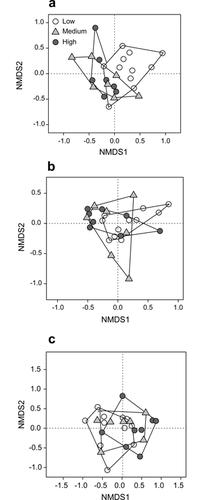PLOS ONE ( IF 2.9 ) Pub Date : 2018-06-19 , DOI: 10.1371/journal.pone.0199245 Ramona Laila Melliger , Brigitte Braschler , Hans-Peter Rusterholz , Bruno Baur

|
Urbanisation is increasing worldwide and is regarded a major driver of environmental change altering local species assemblages in urban green areas. Forests are one of the most frequent habitat types in urban landscapes harbouring many native species and providing important ecosystem services. By using a multi-taxa approach covering a range of trophic ranks, we examined the influence of degree of urbanisation and forest size on the species richness and functional diversity of plants, and ground surface-active ants and spiders. We conducted field surveys in twenty-six forests in the urban region of Basel, Switzerland. We found that a species’ response to urbanisation varied depending on trophic rank, habitat specificity and the diversity indices used. In plants, species richness decreased with degree of urbanisation, whereas that of both arthropod groups was not affected. However, ants and spiders at higher trophic rank showed greater shifts in species composition with increasing degree of urbanisation, and the percentage of forest specialists in both arthropod groups increased with forest size. Local abiotic site characteristics were also crucial for plant species diversity and species composition, while the structural diversity of both leaf litter and vegetation was important for the diversity of ants and spiders. Our results highlight that even small urban forests can harbour a considerable biodiversity including habitat specialists. Nonetheless, urbanisation directly and indirectly caused major shifts in species composition. Therefore, special consideration needs to be given to vulnerable species, including those with special habitat requirements. Locally adapted management practices could be a step forward to enhance habitat quality in a way to maximize diversity of forest species and thus ensure forest ecosystem functioning; albeit large-scale factors also remain important.
中文翻译:

城市化程度和森林面积对植物,地面活性蚂蚁和蜘蛛物种丰富度和功能多样性的不同影响
世界范围内的城市化进程日渐加快,被认为是环境变化的主要驱动力,它改变了城市绿地中的本地物种。森林是城市景观中最常见的栖息地类型之一,拥有许多本地物种并提供重要的生态系统服务。通过使用涵盖一系列营养级别的多类群方法,我们研究了城市化程度和森林面积对植物以及地面活性蚂蚁和蜘蛛物种丰富度和功能多样性的影响。我们在瑞士巴塞尔市区的26个森林中进行了实地调查。我们发现,物种对城市化的反应取决于营养等级,栖息地特异性和所使用的多样性指数。在植物中,物种丰富度随着城市化程度的降低而降低,而这两个节肢动物都没有受到影响。但是,随着城市化程度的提高,营养级更高的蚂蚁和蜘蛛的物种组成也发生了较大变化,而两个节肢动物群体中森林专家的比例也随着森林面积的增加而增加。局部非生物位点特征对于植物物种多样性和物种组成也至关重要,而凋落物和植被的结构多样性对于蚂蚁和蜘蛛的多样性也很重要。我们的结果表明,即使是小型的城市森林,也可以包括栖息地专家在内的大量生物多样性。但是,城市化直接或间接导致物种组成发生重大变化。因此,需要特别考虑脆弱物种,包括那些具有特殊生境要求的物种。适应当地情况的管理做法可以是提高栖息地质量的一种步骤,以最大程度地增加森林物种的多样性,从而确保森林生态系统的功能;尽管大规模因素仍然很重要。











































 京公网安备 11010802027423号
京公网安备 11010802027423号